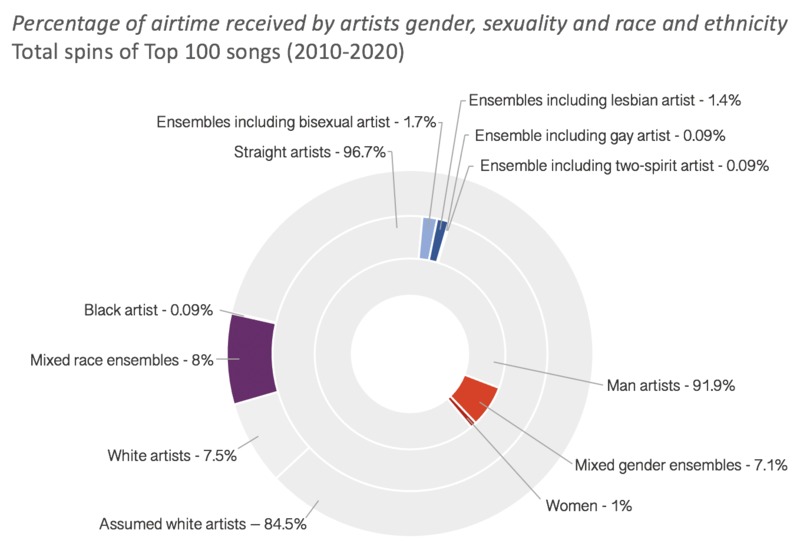Discussion
We have chosen to focus much of our discussion on Black women in active rock, as they are a significantly underrepresented group within this genre for reasons we have described herein, however we will also describe how Indigenous artists, artists of colour, 2SLGBTQ+ artists and women are also structurally oppressed within this genre for many of the same reasons.
Rock music is Black music
To begin, it is important to acknowledge the Black roots of rock music, which sit in stark contrast to the 4% of charting active rock bands in the dataset that include a Black artist. Historically, Black Americans created blues music, which evolved into jazz, and then rhythm and blues (Redd, 1985). In the 1950s, rock and roll was created by white people for white people, to separate the genre from rhythm and blues (R&B), even though the two genres were identical save for race (Redd, 1985). Two genres that were previously combined became segregated, and in reviewing the artists on the radio charts today it is apparent that this segregation continues. Active rock is a genre dominated by straight white men, built on the traditions and labour of Black people who have all but been removed from the industry.
BIPOC and 2SLGBTQ+ artists are absent in the disciplinary domain of active rock
The disciplinary domain of power refers to relations and hierarchies, and in particular organizations, like record labels or radio stations, that rely on surveilled, controlled and disciplined employees and clients (Hill Collins, 2000). In the disciplinary domain of active rock, BIPOC artists are categorized by music genres as a means of subordination, to keep the power in the hands of the white men that produce, disseminate and profit from rock music. This act of categorization has been happening for over a century, yet the white people in positions of power are able to remain naively blind to the harm caused by their privilege when race is viewed as “something that only people of colour have” (D’Ignazio & Klein, 2020, p. 13). Censorship of music produced by BIPOC and 2SLGBTQ+ artists is another form of subordination, that often says more about the racist and homophobic views of the censors than the content of the music. It is often straight white people who are able to make statements on race and sexuality without punishment, meanwhile those who are oppressed because of race and sexuality are silenced. Depending on the race or sexuality of the artist, the industry acts as a gatekeeper of the type of content that can be circulated (Donze, 2017), and as the data has shown it is the hegemonic voices of white men that take centre stage.
BIPOC and 2SLGBTQ+ artists, and white women (to a lesser extent), are maintained in subordination through oppressive powers supported by racist, sexist and discriminatory social institutions, including culture and media within the matrix of domination (Hill Collins, 2000). For example, the straight white male active rock community has supported the ideology that Black women do not have a place in the genre, as demonstrated by having only two Black female artists out of the 249 charting bands: Brittany Howard of Alabama Shakes and Régine Chassagne of Arcade Fire. Both women are in bands that do not fit cleanly into the active rock genre. For example, Alabama Shakes is out of place on the active rock charts as it is considered to be a soul or blues rock band, two genres used to categorize Black people. Although these bands are included on the active rock charts, some may view them as the exception because they are not perceived as active rock artists.
As successful and influential Black female musicians on the active rock charts, Howard and Chassagne are using the hegemonic domain to reverse ideas from the dominant culture, by reclaiming rock music and empowering Black women in the industry (Hill Collins, 2000). The first recording of a blues song by a Black artist was done by a woman, Mamie Smith, in 1920 to great success, leading record labels to seek out other Black women who could replicate her sound (Redd, 1985). Black women have been successful in the rock genre, despite working against a multitude of oppressions in an intentionally racist structure that has taken every opportunity to segregate and subordinate them. Rock and R&B are no longer formally segregated, and the term “race records” is out of use, but the genre’s racial divide is ingrained in the industry as white people continue to appropriate Black music, and profit from the work of Black artists. Criado-Perez (2019) stated that male is the default and female is niche, which is certainly true in active rock radio, and can extend to include white and straight as default, and BIPOC and 2SLGBTQ+ as niche.
The music industry is a capitalist endeavour, with profit as a primary goal, which is inherently exploitative and oppressive. To remain profitable, record labels need to sign (and exploit) several platinum selling artists in order to finance the majority of artists who do not reach the same level of sales (Donze, 2017). Record labels cannot predict who will be the next platinum artist, so they sign many artists as a way of hedging their bets that one will be successful (Donze, 2017). One issue with this system is that labels will look to top charting artists of the past to predict the charting artists of the future. Music producers may overlook BIPOC or 2SLGBTQ+ artists because they want to reproduce past successful artists, under the assumption that listeners will respond well to an artist that is a near replica of a band they already know and like (Donze, 2017). Rock was a genre created for white people to profit, so if decisions are made based on artists of the past, rock music will never be diverse. We are hopeful that the breakthrough BIPOC and 2SLGBTQ+ artists can chart a new path in the genre, to change the future trends of active rock.
Straight white men overwhelmingly dominate the Top 100 charts
As highlighted in the image at the top of the page, artists in the margins take up very little space in active rock. Of the 249 unique artists with songs in the Top 100 charts on active rock radio, 26 bands include one or more women artists, of which four have only women artists. Further, there are no 2SLGBTQ+ solo artists and only one BIPOC solo artist, which suggests that without support from the straight white default, marginalized artists cannot be successful in active rock. The data is simply dominated by straight white men. Bands composed of straight white women, or women and men are the second largest group in the dataset, with a mere 19 artists or ensembles. The hegemonic domain of power justifies the practice of excluding BIPOC, 2SLGBTQ+ and women artists by creating a culture in the active rock community that tells these artists that they are the exception to the industry rules of heterosexual male whiteness, and should not expect a fair share—or any share—of airtime.
A shortcoming of our analysis was the ability to clearly differentiate lead vocalists from the supporting band members. In many cases, the BIPOC, 2SLGBTQ+ and women artists that were highlighted from the data are band members rather than the “face” of the ensemble. Members of the band are important contributors to the charting songs, and in some cases are the most famous member of the ensemble. However, lead vocalists are often the “front man” (another example of the industry’s use of male as default) or public facing spokesperson for a group. As the leader of the band, their voice has a platform and power. They often represent the group in interviews and press, so their voice, opinions and appearance are shared and receive media attention. Even though the data shows marginalized individuals, this does not equate to representation of diverse voices. Additionally, the data does not capture BIPOC artists that may be counted twice if they are part of more than one band. This is an area requiring further study.
When looking at race data, 26 charting bands include a BIPOC artist, of which only four have a BIPOC lead vocalist. Interestingly, two of these four artists are also 2SLGBTQ+: Brittany Howard of Alabama Shakes is a Black lesbian and Cody Bowles of Crown Lands is Mi’kmaw and two-spirit. Whenever possible, we have highlighted the marginalized voices in line with Foucault Welles’ (2014) suggestion to focus on minorities and statistical outliers. In doing so we hope to empower and elevate the artists in the margins, but it should be noted that these artists may have an even smaller voice than the already disappointing data presents.
Canadian content is less diverse than the already non-diverse genre
There are a total of 84 Canadian artists that have 454 songs considered to be Cancon on the Top 100 active rock radio charts between 2010 and 2020. Compared to the overall composition of the active rock artists in this dataset, Canadian artists are less racially diverse, and have only one 2SLGBTQ+ artist, but there are more ensembles with women. Mixed race or ethnicity ensembles make up 7% of Canadian bands, compared to 10% of all charting active rock bands. The gap is even more stark when comparing the songs considered Cancon to all songs in the dataset, where 3% of Cancon songs feature a BIPOC artist, as opposed to 8% of all songs. Similarly, Crown Lands is the only Canadian ensemble with a 2SLGBTQ+ artist, representing 1% of Canadian active rock bands, whereas overall 3% of the bands have a 2SLGBTQ+ artist. In reviewing the total charting songs associated with these 2SLGBTQ+ artists, Cancon songs account for only 0.2% of songs, while overall the figure is much higher at 3%. One area that Canada does better than the average is in female representation, where 12% of Canadian bands (versus 10% overall) and 9% of Cancon songs (versus 8% overall) are female or mixed gender ensembles. In this dataset, the Canadian figures do not align with Canada’s general BIPOC, female and 2SLGBTQ+ populations, suggesting that it is not for a lack of diversity within the country that Canadian active rock artists are overwhelmingly straight white men.

